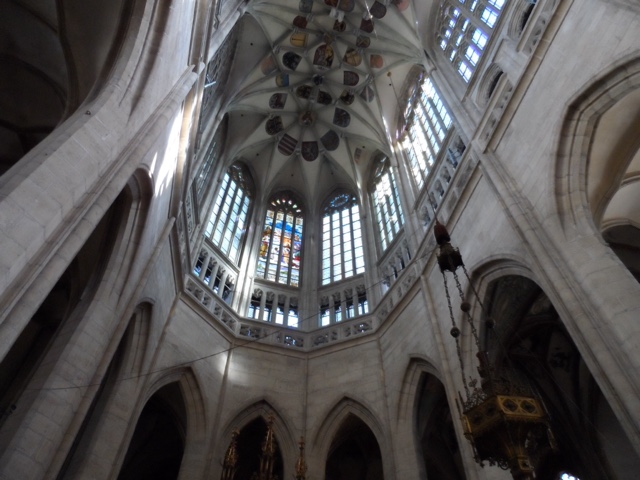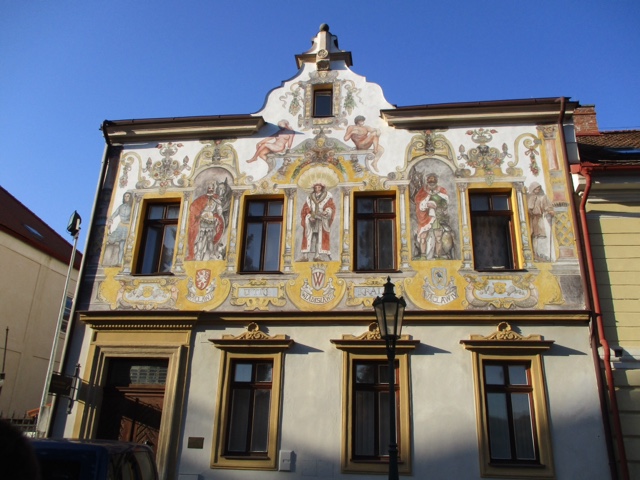We passed a travel agent and had a look at all the vacation ideas. For Australia, they were tempting the Czech people with photos of the 12 Apostles, a random red road in the Outback and the Opera House. Can sort of see it here, top right...
You see a lot of this here...
Had a look in a few souvenir shops, they love chandeliers here! And then a sit in the 'square'.
And it seems like a complicate language - lots of 'z's and consonant combinations. There was a sign on a door with 'otevirejte od sebe' which translated to English 'push'...
Time to join our tour - we are heading off to Kutná Hora, a small town about an hour's drive from Prague. We have our driver (we don't learn his name)...
..our guide, Phillip, and two Chinese girls, Huan Huan and Jessica. Phillip actually speaks some Chinese as he has a Chinese girlfriend, but the tour is in English, thankfully! And we're off.
As we start our journey, Phillip has some questions for us all, if we get it right, we get a chocolate coin. The population of Prague is 1.3 million, the population of the Czech Republic is 10 million, so there's a lot who don't live in the capital. I randomly get close to guessing the population of Kutná Hora - it is 22,000, I had guessed 20,000, so I got a coin!
Kutná Hora is famous for three things - the Sedlec Ossuary, the Church of St Barbara and the silver mine. In medieval times, there was a silver rush here and people flocked. There have been a number of King Wencelases here (both good and bad) and it was Wencelas II who brought in rules and laws to control the place, including the rule that around 6 of every 10 units of silver brought out had to be paid to the King.
As we get all of this base information, we are driving through lovely countryside...
Also passed the Skoda factory. The production of these cars is an important industry here.
We also learn that the potato is one of the most important foods here (like Ireland). Phillip also shows us pictures of some traditional foods, like fried cheese with tartare sauce and fruit dumplings. Also, the national sports are football, tennis and ice hockey, and he shows us a famous ice hockey player who is still playing at age 45. Not sure these are all his own teeth...
..and I mean the hockey player, not Phillip!
Our first stop is the Ossuary, which is decorated with over 40,000 bones. These are either from people who died during the Black Death (or plague) or during the wars. Apparently they were all just piled up, then an artist came and said he could use them to create artistic pieces of interest. And the result is extremely quirky and interesting and macabre. There is a chandelier made of all the human bones...
The Ossuary is outside of Kutná Hora and they decided they needed a church in the town as well, so with the mining money and three different architects over a long time, the Church of St Barbara was built. Barbara's father was a man who hated Christianity so much, he locked Barbara up inside a tower to prevent her being converted.
Somehow, a priest got in and did convert her so her father beheaded her! He was then struck by lightning and died! Lovely bedtime story...
St Barbara is usually seen with her tower, a cup (to hold the body of Christ) and a sword (to show the beheading). She is the patron saint of miners.
The church is astonishing and impossible to show the massiveness and impressiveness of it in photos, this is the best we can do...
This is Phillip, the Chinese girls and I trying to take it all in!
They have a tribute to the miners - without them, there would be no town and no church. They wore white so if anything happened in the mine, they would be easy to see and find.
There are gargoyles outside to - they are evil but they band together to prevent evil from entering the church somehow...
Outside the church, there is a lovely view of Kutná Hora, and the Jesuit college which has a row of sculptures along a road called the bridge, even though it's not over water. There are vines growing, bottom left here...
Down into the town itself. The cobblestones have the brick lines in rows in the centre of the roads as a medieval form of guttering, to drain the water.
There were more stories that were fairly gruesome - a guy who was blind in one eye, became blind in the other but lead a crusade war against another blind guy - not sure who won that one!
There was St. John, who was a confidante of a queen and refused to tell her secrets to the king, so he was tortured and drowned. Lots of gory stuff.
The symbols of Kutná Hora can be seen everywhere - a lion (one tail for female, two tails for male), an eagle and a cup. There is an interesting mosaic that is ancient showing a miner (on the right), three of the kings who held form the city and a mint worker (on the left) - there was a mint here - the silver went straight to it, so the mint workers were respected, as were the miners.
Back on to the bus and back to Prague, it was a really interesting and informative tour and a lovely town.
There was a bit of a display of ye olde crafts in the square, which was interesting - weaving and ironworks and others.
Then dinner at a great open-air restaurant before heading home.





























THAT CHURCH! <3
ReplyDelete